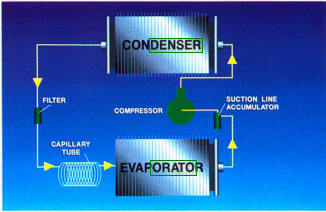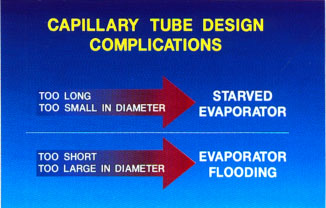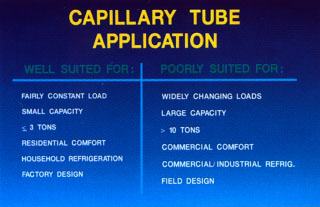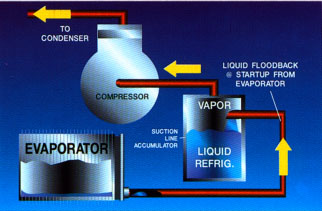Capillary tube

Capillary tube is the simplest of all devices of the account. It is a fixed length of the small-diameter copper pipe, usually with internal diameter from 1/16 to 1/8 inch. It is normally located just ahead of the evaporator, as shown here. Due to its high resistance to the flow friction, it limits, or meters, flow of liquid refrigerant from the condenser to the evaporator. More in length or less in diameter, "hats" tube, the more pressure difference that it creates. Often spiral to save space and for protection from the capillary tube from damage.
All the fluid leaving the condenser must pass through the capillary tube before entering the evaporator. Therefore, its diameter and length must be selected in such a way that the design load conditions bandwidth pipe-exactly the same as the pumping capacity of the compressor.

If the capillary tube is too long or too small diameter, or both, of the evaporator will be sorely lacking refrigerant and too liquid refrigerant will be stored in the capacitor.
The combined effect will be to make the system work at too high a pressure, and with insufficient cooling capacity. In addition, operating costs will increase. These symptoms occur when the correct size of the capillary tube is partially plugged garbage.
If the capillary tube is too short or too large diameter, or both, of the evaporator will be overfed. This may allow the ingress of liquid refrigerant in the compressor, and too little of the refrigerant will be built in the condenser. The cumulative result will cause the system to operate at too low a pressure, and perhaps too high suction pressure. These conditions result in the reduction of the cooling system capacity.

Because its design is critical, "hat" tubes usually custom-designed and installed at the factory and not in the field. It is best suited for close-coupled split-systems or embedded systems. When it is properly select and apply a capillary tube compensates for changes in load over a reasonable range of operating conditions. It is poorly suited for the jobs that are large changes in the cooling load. As a result, it is most often used for equipment with three tons or less cooling power, where there are constant loads. Domestic refrigerators and freezers, air conditioners and small Central air conditioners and heat pumps, examples of its use.
With capillary tube is very small in diameter, just plug it in the garbage, which circulates the refrigerant. For this reason, a liquid line filter is usually installed in front of the capillary tube.

Unlike modulating types of devices of the account, the capillary tube has no means of stopping the flow of the liquid refrigerant into the evaporator during the off cycle. When the compressor stops, the pressures of high and low sides to equalize flowing through the open capillary tube. Any liquid left in the capacitor at the time of Cycling off tends to accumulate in the evaporator, and remains there until the compressor is not switched on again.
This fluid has the potential to be drawn into the compressor at start-up; this action causes traffic jams, especially if the system is overcharged. In some cases, the fluid can migrate into the crankcase of the compressor during off; there, it is mixed with the oil. This will cause foaming and a lack of lubrication when the compressor starts again. Thus, the suction line accumulator are sometimes installed in systems using the "cap" of the tube. Battery captures the liquid refrigerant, which returns the system in the form of steam. In addition, special attention is paid in charging systems that make use of the capillary tube...
|




